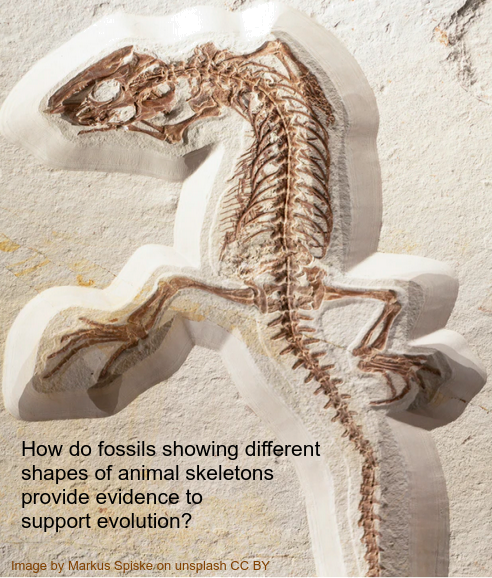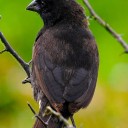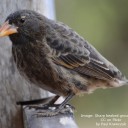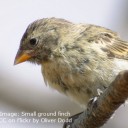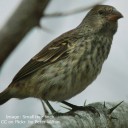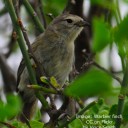Evolution examples
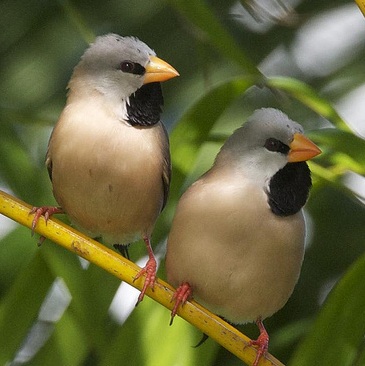 Students investigate adaptive radiation and industrial melanism as well as gradual divergence of populations into separate species. All of these ideas have been contested, especially in social media, so IB students should give them close scrutiny to see if the biological explanations are convincing and to understand the roles of genetic variation and overproduction of offspring in evolution.
Students investigate adaptive radiation and industrial melanism as well as gradual divergence of populations into separate species. All of these ideas have been contested, especially in social media, so IB students should give them close scrutiny to see if the biological explanations are convincing and to understand the roles of genetic variation and overproduction of offspring in evolution.
Lesson Description
Activity 1 - Adaptive radiation
If two (or more) animals share the same basic structure in part of their bodies, but the structures are quite different in shape or size this is considered to be evidence that the animals shared a common ancestor who possessed a rudimentary form of the same structure.
Compare the structure of the beaks in the Galapagos finch images below. Each beak is adapted to eat different types of food. Try to imagine what their common ancestor might have looked like.
See even more images in this great diagram from Larrousse of finches
Science often works in this way. First making a prediction, using a theory then testing the prediction by searching for evidence to support the theory. Fossils of animals with intermediate or primitive forms of the structures often provide this evidence.
Complete the ![]() activity on finch beak sizes in Galapagos and try to explain the process of evolution.
activity on finch beak sizes in Galapagos and try to explain the process of evolution.
Activity 2 - Experiment to illustrate selection pressure in industrial melanism
The example of the different forms of the Peppered moth provided similar evidence of a gradual change in the characteristics of a species during the 1930's.
Experiment with the sliders and look at how visible the moths will be to birds, depending of the colour of the tree bark.
Activity 3 - Peppered moth "selection pressure" activity
Carry out the![]() Peppered moth simulation activity on the worksheet below.
Peppered moth simulation activity on the worksheet below.
When doing the activity, if the students are not very aggressive about their pecking the moth population can increase quite rapidly. In this case there are some interesting points for discussion, and adaptations which can be made to the experiment.
- A high population of peppered moths in nature would possibly
- have less food and so may reproduce more slowly.- so you could skip a moth reproduction every other go.
- have a higher death rate, and so die from disease - so you could remove half the moths at the end of a go
- support a larger bird population - so both students could catch moths.
- If students (birds) aren't catching many moths some changes could evolve in the bird population.
- Birds evolve better adapted beaks, so students change tweezers to sharper, metal tweezers (better beaks) which which students might catch more moths.
- Birds could spend longer feeding - an evolution in behaviour - so students take 30 seconds of feeding.
We should mention - gradual divergence of populations into separate species
The theory goes that if two populations are isolated from one another and there are different selection pressures then gradually the different populations will become more and more different until there is a point where they can no longer reproduce together any more. This leads to the creation of a new species.
For example, finches isolated on different islands eating different food begin as the same species. Gradually over many years the characteristics of each population become more and more different. After a certain time, these differences become so important that even if a bird from each island was put together, it would not be possible to reproduce and we would describe these two animals as separate species
Teachers notes
Bell activity - guiding questions
This can be projected on the screen as students arrive, or posted onto a learning platform before the lesson.
The process of fossilisation is not required in detail but an understanding of how fossil evidence can support the concept of evolution is important. This is an opportunity to discuss dating or rocks, and the formation of fossils.
Activity 1 - Introduction to finches
Students need to have seen some finches before they can understand the ideas about adaptive radiation and gradual divergence. The photo gallery provides an opportunity to think about the usefulness of beak shapes for feeding, while introducing the finches. Students will then be ready to look at the data and the evidence for evolution.
You can find Adaptive radiation model answers on this page (teachers can control student access in the group setting on the student access. Use the "add/edit content" button at the top of the page.
Activity 2 - Main activity
The images in this activity provide an illustration of selection pressure through predation, using the example of industrial melanism. Here the emphasis is on population sizes of two phenotypes rather than gradual radiation. Where there is variation in the phenotype of a population evolution can be seen within just one or two generations.
Activity 3 Extension / Alternative
This activity models the effects of selection pressure, and the students take the rolls of predators, and moths.
When doing this activity with the cut out peppered moths, if the students are not very aggessive about the pecking the moth population can increase quite rapidly. In this case there are some interesting points for discussion, and adaptations which can be made to the experiment.
- A high population of peppered moths in nature would possibly
- have less food and so may reproduce more slowly.- so you could skip a moth reproduction every other go.
- have a higher death rate, and so die from disease - so you could remove half the moths at the end of a go
- support a larger bird population - so both students could catch moths.
- If students aren't catching many moths some changes could evolve in the bird population.
- Birds evolve better adapted beaks, so students change tweezers to sharper, metal tweezers (better beaks) which which students might catch more moths.
- Birds could spend longer feeding - an evolution in behaviour - so students take 30 seconds of feeding.
Excellent diagram of Galapagos finches and and explanation of adaptive radiation video
http://global.britannica.com/science/adaptive-radiation
Other resources which might be useful but didn't make it into these activities
A paper in Nature from Galapagos on Finches shows evolution of beak depth in 2006
Nature magazine - Oven birds - brilliant diagram
http://www.nature.com/nature/journal/v506/n7488/fig_tab/nature12874_SF1.html
Great summary of the evidence for evolution - including good diagrams of adaptive radiation in marsupials and mammals
*********
Peppered moth classroom paper activity kit - to buy
Peppered moth evolution - an update in the light of creationist criticism.
Peppered moth online simulation and information site
Extension idea using COVID-19
The modelling of mutations and the evolution of genetic variants of the COVID-19 virus illustrates quite simply how random mutations can cause the appearance of advantageous traits in organisms. While a virus doesn't reproduce without a host cell, the reproduction process involves copying the RNA millions of times, resulting in mutations which made cause the virus to be less effective, and which disappear, or they may give the virus an advantage and develop into a 'Variant of concern". This short video from VOX ![]() Why so mant Covid-19 Variants of concern? describes the gradual evolution of the COVID-19 virus into variants. It could make an interesting extension, or a link to HIV and AIDS of the Human physiology topic.
Why so mant Covid-19 Variants of concern? describes the gradual evolution of the COVID-19 virus into variants. It could make an interesting extension, or a link to HIV and AIDS of the Human physiology topic.

 IB Docs (2) Team
IB Docs (2) Team

